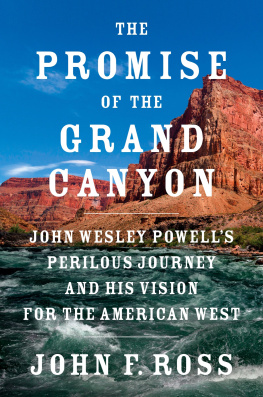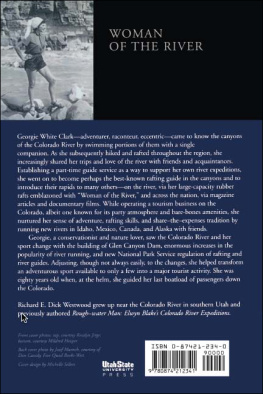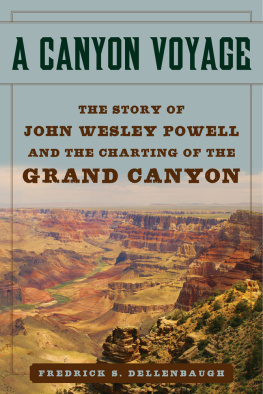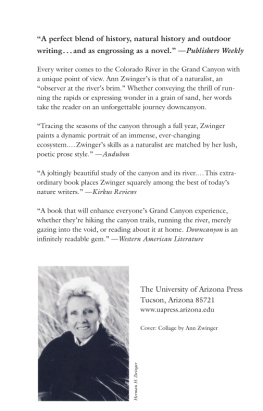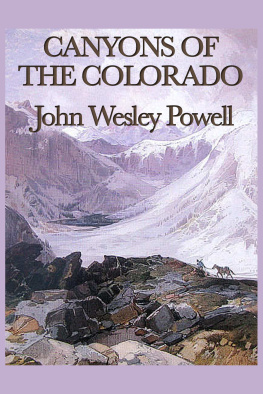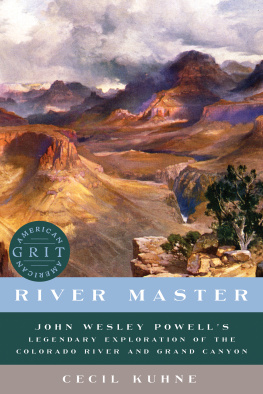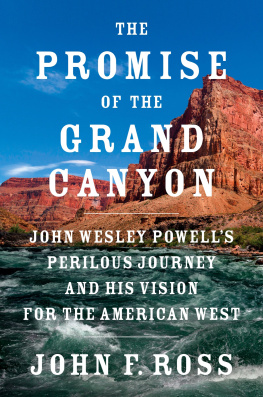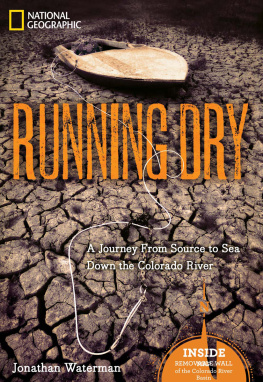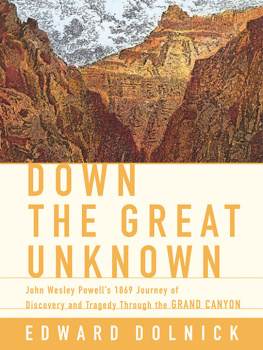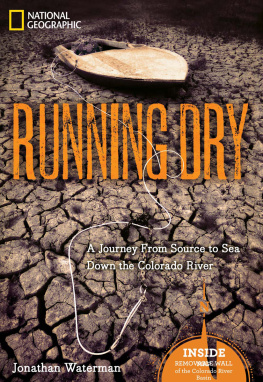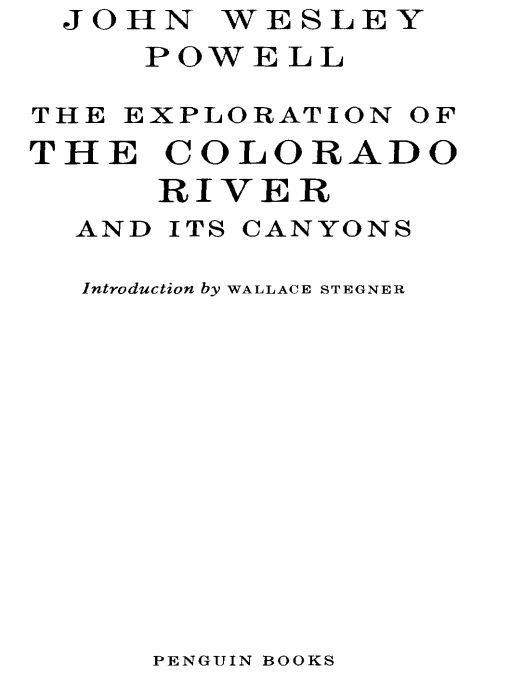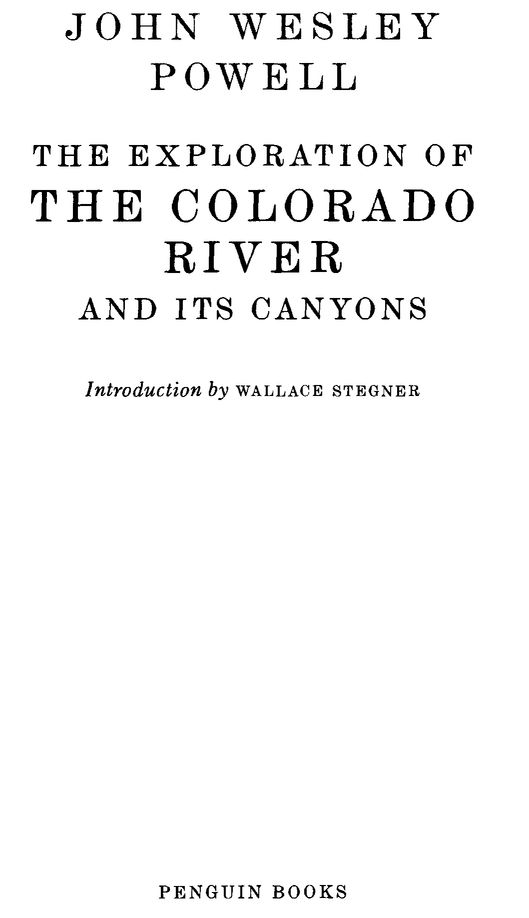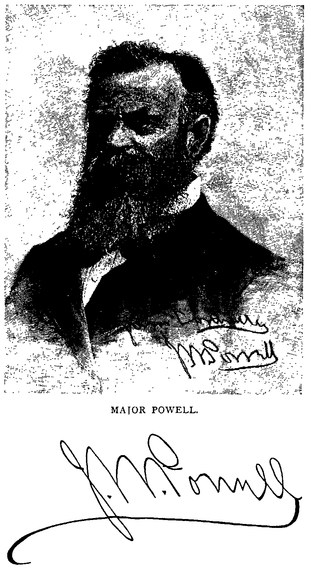Table of Contents
THE EXPLORATION OF THE COLORADO RIVER AND ITS CANYONS
JOHN WESLEY POWELL (1834-1902), the one-armed major, led expeditions in 1869 and 1872 that explored, mapped, and obtained geologic data on the Colorado River. As director of the U. S. Geological and Geographical Survey (1884-1891), Powell oversaw the preparation of detailed maps and surveys that clarified Western topography, geology, and irrigation. A pioneering anthropologist, he was the first director of the U.S. Bureau of Ethnology.
WALLACE STEGNER was the author of numerous works of fiction, history, and biography, including Beyond the Hundredth Meridian: John Wesley Powell and the Second Opening of the West.
INTRODUCTION
Major John Wesley Powells 1869 expedition down the canyons of the Green and Colorado rivers was the last great exploration within the continental United States, and an exploit of enormous importance in opening the West after the Civil War. But it is important to point out that it differed from most explorations. There were a lot of things it was not.
It was not a government expedition. It had no imperial purposes; it was not interested in expanding the national domain, clarifying disputed boundaries, or shutting out rivals. It was going to plant no flags or crosses and proclaim United States sovereignty over new territories and new tribes. It was not motivated by fear that someone else would slip in and gain an advantage, as Vizcainos voyage up the Pacific coast in 1603 was born of the fear that Drake might have discovered the Straits of Anian and the fabled opening of the fabled Northwest Passage; or as the excursion of Lewis and Clark up the Missouri was partly motivated by British inroads on the Northwest fur trade and by British rivalry for the Oregon country. The territory the Powell party was organized to explore was firmly American, and had been ever since the Mexican War.
The Powell expedition was as barren of official backing as it was of official intentions. Congress had not authorized it, as it had authorized the western surveys of Clarence King, Ferdinand V. Hayden, and Lieutenant George Wheeler. No congressional appropriation funded its preparations. No department or bureau of government sponsored it even informally, nor did any great semi-official organization, such as the Philosophical Society, which had backed Lewis and Clark. The meager funds that Powell had at his command came out of his own pocket, from the Illinois Natural History Society for which he was secretary, and from the Illinois Industrial University. All he had in the way of government aid was a few instruments and some good advice from the Smithsonian, plus permission from Secretary of War Edwin Stanton to draw rations for ten men from any western army post.
The leader of this expedition was a one-armed Civil War veteran, once a major on Grants staff at Vicksburg and Shiloh, now a self-made professor of geology at Illinois Wesleyan College in Bloomington, Illinois. He had so far published nothing and made no mark, apart from a distinguished record in soldiering and a local reputation as a collector of shells. He was the sort of amateur scientist, inspired by the fecundity and newness of the continent, that all of our frontiers have developed: a natural historian, an enthusiast with minimal formal training but with vast energy, a considerable gift for persuasion and promotion, and an imagination that was an expanding universe.
Small as his scientific credentials were, they represented all the science that was going along on the trip. Of his crew of nine, one was his brother Walter, moody and war-damaged, notable mainly for his great strength and a fine bass voice. The only reasonably well-educated man in the party, besides Powell, was Oramel Howland, a printer. The rest were hunters and trappers, belated mountain men, drifters and pick-ups. Howland, his brother Seneca, Jack Sumner, Bill Dunn, and Billy Hawkins had all spent the previous year in the Colorado mountains with Powell. They enlisted for the river voyage partly because they hoped the inaccessible beaches and bars of the Colorado River might turn out to contain gold, but mainly because they were restless, hardy, and looking for adventure. Two drifters were added to the party just before departure: Andy Hall, a husky young bullwhacker, and Frank Goodman, an Englishman in search of frontier thrills. The tenth man, George Bradley, had been a sergeant at Fort Bridger, bitterly anxious to get out of the army. Finding that he was a Maine man, and knew boats, Powell pried him loose and took him along. He turned out to be one of the best.
And the purpose of this shoestring expedition? Only to discover. To find out. To observe, analyze, map, comprehend, know. The disinterested search for new knowledge is an important component of any exploration, though it is often subordinated to imperial or economic purposes. With Powell and his men, if we can discount the hope for gold (which the river quickly discouraged), and Powells private ambitions (which were inextricable from the search for new knowledge), intellectual curiosity was the prime motive. They went down the river for the same reason the bear went over the mountain.
Samuel Bowles, the distinguished editor of the Springfield Republican, had run into Powell in the Colorado mountains in the summer of 1868, and sent back to his paper an advance notice of his intentions. Bowles spoke of the mocking ignorance and fascinating reports of the courses and country of the Colorado, of the blank space on the map one to two hundred miles wide and three to five hundred miles long. Is any other nation so ignorant of itself?
And of Powells plans: From here the explorers will follow down the Grand River, out of the Park into western Colorado, and then strike across to the other and larger branch of the great Colorado River, the Green, and upon that or some of its branches, near the line of Utah, spend the winter in camp ... preparing for the next summers campaign. The great and final object of the expedition is to explore the upper Colorado River and solve the mysteries of its three hundred mile canyon.
He thought the adventure dangerous, for folklore and Indian reports both spoke of inaccessible and probably unrunnable canyons, rapids, falls, sucks, and cataracts, and there were only three known places from which an escape could be made: in the Uinta Valley, where Powell had camped briefly in 1868 and where there was an Indian agency on the Uinta; at Gunnisons Crossing (Greenriver, Utah), where Lieutenant Gunnisons Pacific Railroad survey had projected a route; and at the mouth of the Paria, where in 1776 Father Escalante had crossed back toward the Hopi towns and Santa Fe after failing to make it across to Monterey.
Dangerous, but importantas important, Bowles thought, as the work being done by any American scientist. He thought the expedition fortunate in its commanderwell-educated, an enthusiast, resolute, a gallant leader. And he emphasized by the vagueness and inaccuracy of his own figures the need for solid information. The three hundred mile canyon he spoke of would turn out to be a chain of canyons more than a thousand miles long, as uncrossable and almost as unrunnable as advertised, entrenched up to six thousand feet deep in an unknown desolation as big as Texas.


